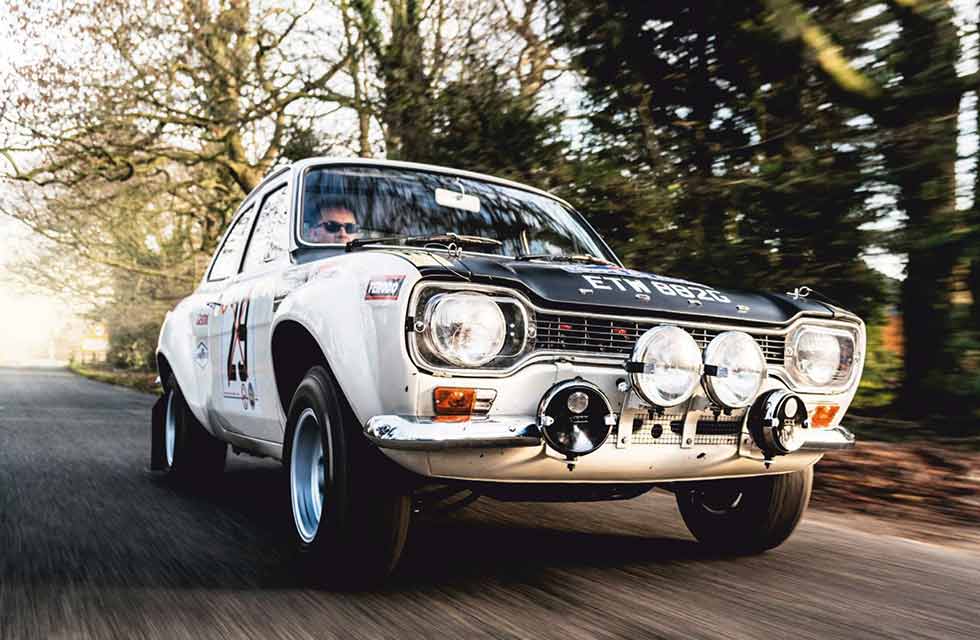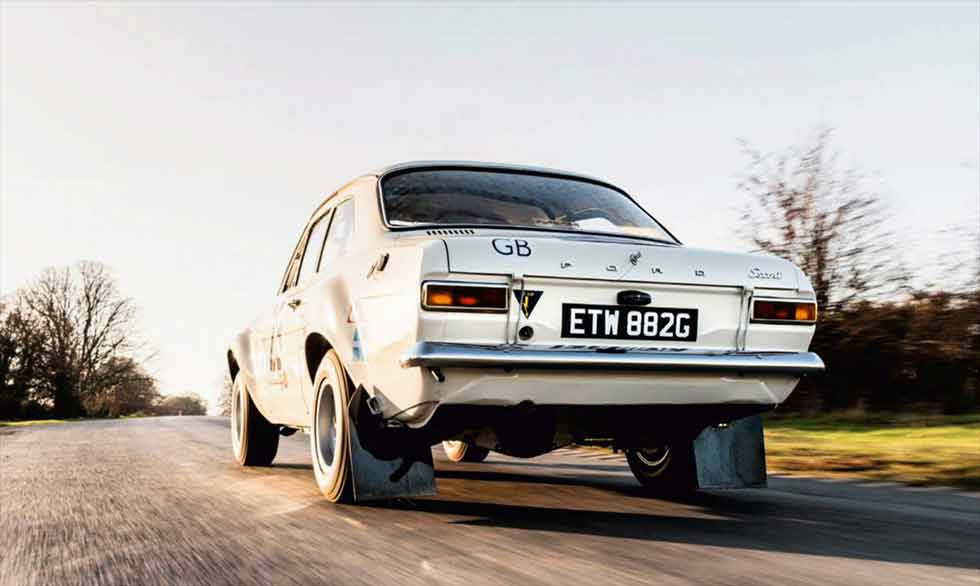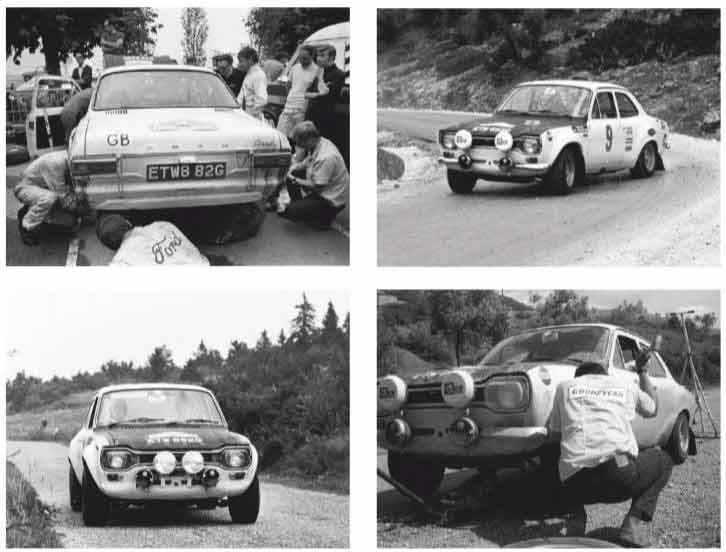
We drive the Roger Clark Escort that pioneered a crude but crucial rally modification. Give it the Works A drive in an ex-Roger Clark Ford Escort Twin Cam rally car that won’t take slow for an answer. The Escort is Britain’s most successful rally car, the rear-wheel drive versions remaining competitive for over a decade. We find out what made them so special from behind the wheel of this ex-Roger Clark Twin Cam. Words Russ Smith. Photography Jonathan Jacob.
GIVING IT THE WORKS Roger Clark’s Escort driven
There’s a lot of sense in the old adage about never meeting your heroes; they are unlikely to live up to expectations, and may even try to sell you their latest book or CD. But I’ve never yet found a downside to driving one of their cars. It takes you a step closer to their world, but not so near as to wobble the pedestal they have been placed on.

There’s no chance of meeting today’s human hero because he sadly left us 21 years ago, but all British petrolheads who grew up in the Sixties and Seventies will have a place in their hearts for British rally ace Roger Clark. He left a legacy so strong that in 2004 the historic version of the RAC Rally was renamed the Roger Albert Clark in his honour. What Roger mostly drove was Ford Escorts, including the works car that I’m being allowed to play with today – a meticulously restored hero in steel. This may not be one of the cars that stacked shelves with trophies – it only finished one international rally, though that was in third place – but it is an honest-to-God Escort Twin Cam built at Ford’s Boreham-based Motorsport department. It’s a prototype ‘mule’ that ran in various forms. And the first driver to pilot it on a rally, the French Coupe des Alpes in 1969, was Roger Clark.
‘An honest-to-God Escort twin-cam, first piloted in a rally by Roger Clark’
We’ll come back to that, because right now I’m keen to strap myself into Roger’s seat and get a taste of what a highly-tuned Escort Twin Cam is all about. It’s something I hope and expect will bear no relation to the base-model MkI 1100 that I learnt to drive in, though the profile is much the same. And this car’s bubble arches, quarter-bumpers, bonnet pins, spotlamps and alloy wheels serve as reminders of all those Clark wannabees that growled around the roads near my Essex home back then – though usually with nothing more potent than a tweaked 1300 lump and a vivid imagination. Slipping easily inside – there’s only a rear cage – the seat is very much the period bucket item that was popular back then and sold by the dozen from tuning shops like nearby Ripspeed. Its ribbed charcoal cloth grips my backside well enough but that is the extent of its duty, the back barely extending to shoulder level with none of that health-and-safety headrest nonsense. Different times. At least I’m not planning to rag it through a Kielder Forest stage today.

The blue webbing of the Willans harness is a remarkably good match for my 21st century interpretation of a Seventies rally jacket – no sponsors yet – and I buckle the four tongues of it together. The steering wheel falls perfectly to maximum-input bent arms, largely because of the remarkably deep dish of its long, drilled spokes. I’ve not seen anything like it since the 1979 Custom Car Show at Alexandra Palace. The car’s owner, David Watkins, has already warmed its rally-spec Lotus Twin Cam through, so it just remains for me to pump the pedal and turn the key.
The result is a loud cough followed by a busy, agricultural growl. Closer to the power tool than philharmonic end of the sound spectrum, the first impression is of an engine that’s never going to be revered for its vocal abilities. Especially when it settles to idle at 1600rpm and sounds like someone’s left a tin tray of spanners on top of it. I’ve been told to keep plenty of revs on when letting the clutch up, which smooths the engine out a bit. I heft the ZF five-speed’s lever left and back into its dogleg first gear, release the fly-off handbrake, let the super-heavy, short-travel clutch out… and stall. Several times. David laughs and says, ‘Don’t worry, the last person to drive it other than me was [Irish rally driver] Rosemary Smith on historic stages and she kept stalling it too. Use more revs.’

That helps, and with a wriggle as the chunky-treaded 185/70 Dunlops (not Goodyears as stickered on the sides) find some grip on the damp tarmac, I’m off. Quick grabs for second and third gears prove far more successful, though the lever still needs a meaty shove, and my shoe keeps catching on the metal footrest next to the clutch. It’s actually the transmission ZF designed for the Fiat Dino 2.4 – Ford Motorsport didn’t have the budget for a bespoke unit – but I suspect the shift linkage is different because no Dino feels this physical. ETW 882G is significant in being the first works Escort to be fitted with the hefty ZF ’box, in its test-mule role, though not before the Escort’s tight transmission tunnel had been ‘relieved’ in a few places using a large hammer. It was quickly found that the ratios were too tall and widely spaced to be any use in a rally. A solution was found in using the much stronger 5:1 ratio ‘Atlas’ rear axle from a Transit van – another first for this car and something that soon became the rule for competitive rallying Escorts.
Heading down the road, it’s still pretty raucous, but from inside with the window now wound up, I’ll admit the noise isn’t too bad. This car was built – and then rebuilt more recently – to Group 2 spec, which means it has to run full interior trim – from carpets to door cards and headlining. But you do feel absolutely everything mechanical that’s going on; it’s like sitting on a washing machine. After a few runs up and down a narrow and twisty road, I feel I’m starting to get it… except I’m not. It’s all so physical, and below 4000 revs that highly-strung engine sounds grumpier than Jack Dee in a Post Office queue. I’m torn between the need to acclimatise and the growing realisation that if you try and drive this Escort like a normal car, it hates it. It snorts and barks, and everything feels heavy and recalcitrant, like you’re trying to wrestle a reluctant Alsatian into the back of a Volvo estate.

I take a deep breath and really floor the throttle pedal in second, then it clears its throat and just flies. Above 4000rpm everything smooths out; suddenly you’re in a completely different car. Up through the gears and above a certain speed everything clicks into place and there’s no fight – it’s all about finesse, though the clutch never gets any lighter. The Escort is up on tiptoes and dancing. You feel like you could make it do anything. Going through the same twists at around twice the speed feels easier to do. Every slight fluctuation in the road surface is not just faithfully transmitted through the incredibly direct steering, but amplified. This is good stuff; the Escort feels like it weighs nothing and with around 180bhp from the 1835cc engine it accelerates like crazy in any gear. The handing, too, is almost beyond belief.
Without much rubber on the road the tail can easily kick out, whether you ask it to or not, but an instinctive twitch of wheel and pedal snaps it back in line – or out again if you want. It flatters, making me feel a much cleverer driver than I am. I now understand Roger Clark’s quote, ‘I can personally vouch for the number of times an Escort has helped me to a big win where no other car in the world would have coped. I would not say they were indestructible, but it is nice to have a machine on your side at all times.’ In a nutshell, it’s a bit mad, but it’s your mate and it’s got your back.
With all the fuss that’s made about how they sharpen things up, I’m surprised to hear that this car doesn’t even have a front strut brace. David informs me that Roger Clark wouldn’t have them on his rally cars. He believed that an impact with an obstacle might then damage both sides of the suspension, reducing his chances of limping the car to the next service stop.

Only the brakes are at all disconcerting, and then only until I get used to them. Much like the clutch, pushing the pedal feels like stepping on a rock, but it works – there’s actually plenty of braking force there, it just requires some muscle memory to be dragged from my dim and distant pre-servo past. Understood and adapted to, it’s another thing that makes the car easy to drive fast, as you can modulate braking force more easily and precisely to avoid lock-ups than would be the case with a servo.
Giving the brakes a serious test reminds me that I have no idea how fast we’ve been going; learning to do a bit of Strictly with an unfamiliar, hyperactive car hasn’t left time to glance at the speedo up until now. Just as well we’ve been on very lightly-trafficked roads. Not many works Escorts had speedometers back then; this one does, but it reads in kph – and appears to be wildly inaccurate. I quickly give up trying to work it out, and only later discover that to give it some semblance of use there are three small red daubs of paint on the glass that correspond roughly to 30/40/60mph.
The lack of outside mirrors also take a bit of getting used to, but until much later they were rarely fitted to rally cars – they’d just be something else to knock off. I’m only half-joking in my suggestion that most Escort drivers could probably get a good view of the road behind through their side-windows for much of the time.
Now restored and stickered up, ETW 882G appears exactly as it did for Roger Clark and navigator Jim Porter on its debut outing in September 1969, at the Coupe des Alpes. The only notable difference is that 50 years ago, it didn’t actually have a Lotus Twin Cam engine under the bonnet. Instead, there was a mildly-tuned 2.3-litre version of Ford’s Cologne V6 (already proven on race tracks in German Capris) squeezed into the narrow bay. An odd choice for rallies, perhaps, but Ford Motorsport had a good reason – it was already assessing options for the following year’s massive publicity opportunity, the London-Mexico World Cup Rally, and didn’t trust the highly-strung Lotus engine to survive weeks of hard use with South America’s variable fuel qualities. It was something a less-stressed V6 might more readily cope with, so that’s what Clark was handed to tackle the rally in, to see if the idea worked.
It didn’t, not helped by being nailed together in a rush with no time for testing. Roger Clark hated it, saying, ‘It doesn’t handle, it doesn’t work!’ It wasn’t just the understeer caused by the heavy V6, the engine and gearbox also overheated. The latter would tighten up until Clark couldn’t even change gear. But when mechanics checked it at service stops, it would cool and all seem fine again. In the end Clark lost patience and thrashed the car until it broke.
Back to the Boreham drawing board, ETW 882G soon reappeared in World Cup Rally trim for extensive testing duties for that event, complete with the distinctive bars from roof to strut tops. It is unknown what was under the bonnet at that point, but the car never went to Mexico. Instead, ETW 882G was rebuilt again – this time to Group 2 spec with a 1600 twin-cam unit for Ove Andersson and Jim Porter to take on the Acropolis Rally in Greece from May to June 1970. It had been converted to left-hand drive too. Says David Watkins, ‘That was quite normal – they used to swap the wheels back and forth all the time, depending on who was going to use it and where.’
This would bring ETW 882G’s only success (and only finish) in a significant event. Andersson brought it home third, behind two Alpine-Renault A110s but nearly ten minutes ahead of fourth-placed Jean-François Piot in Ford’s other works Twin Cam, sister car ETW 883G. Flipped back to right-hand drive but otherwise unchanged, by September ETW 882G was in South Africa for the Total Rally in the hands of Tony Fall and Henry Liddon. They were leading until the last night, but had a big ‘off’ and were forced to retire. After that, it did a few African rallies and in 1971 was sold to a dealer in Ethiopia, after which it disappeared off the map.
Then, just over five years ago, David Watkins – who collects and rallies works Escorts – heard about it from contacts in Africa. ‘They arranged the paperwork and import for me. There was a lot of blind faith in what I was buying, but it turned out to have been well restored and was right. It was just a bodyshell on wheels, but all the original parts were still with it, including a lot of rare items. All I had to do was put the jigsaw together. It was nice to rebuild this as a period-correct car – I have others that I use for rallies that have all the up-to-date performance and safety equipment. This is more for display and local runs, though I did win the Tornado Trophy [made from a Tornado jet part] at the Goodwood Festival in 2018 for the longest jump on the rally stage – 43ft.’
It’s definitely no showboat then, and that’s the clear impression I get from hurling it ever more boldly along damp, mucky Yorkshire lanes. I’ve never really got the fuss around Escorts, and certainly couldn’t relate to the prices that hot ones now fetch. But today’s experience has changed all that. By building machines with the sole purpose of winning rallies, Ford created something really focused that connects directly to drivers. Roger Clark summed it up best in his book, Sideways to Victory, ‘The electrifying tingle of a car built for competitions, and nearly right from the beginning, is something you just can’t describe, but the Escort had it.’ And that’s why people will now happily pay Ferrari 308 money for what is really so much more than just a tin box from Essex.
Thanks to David Watkins, and Mark Heath of the Ford AVO Owners Club.
1969 Works Ford Escort Twin Cam
Engine 1835cc iron block/alloy head straight-four, dohc, two 45DCOE Weber carburettors
Max Power 182bhp @ 7000rpm
Max Torque 135lb ft @ 5000rpm
Transmission Five-speed manual, rear-wheel-drive
Steering Rack-and-pinion
Suspension Front: independent by MacPherson struts; Rear: solid axle, semi-elliptic leaf springs, radius arms and telescopic dampers
Brakes Discs front, drums rear
Weight 850kg (1872lb)
Performance Top speed: 139mph
0-60mph: 6.0sec
Fuel consumption 18-20mpg
Cost new £n/a
Approximate value £190,000






